Impacts of Climate Change on the Potential Productivity of Eleven Staple Crops in Rwanda
Abstract
1. Introduction
2. Materials and Methods
2.1. Study Context
2.2. Input Data
2.3. Yield Model Specification
2.4. Predicting Climate Change Impacts
3. Results
Climate Change Impacts
4. Discussion
Author Contributions
Funding
Acknowledgments
Conflicts of Interest
Appendix A

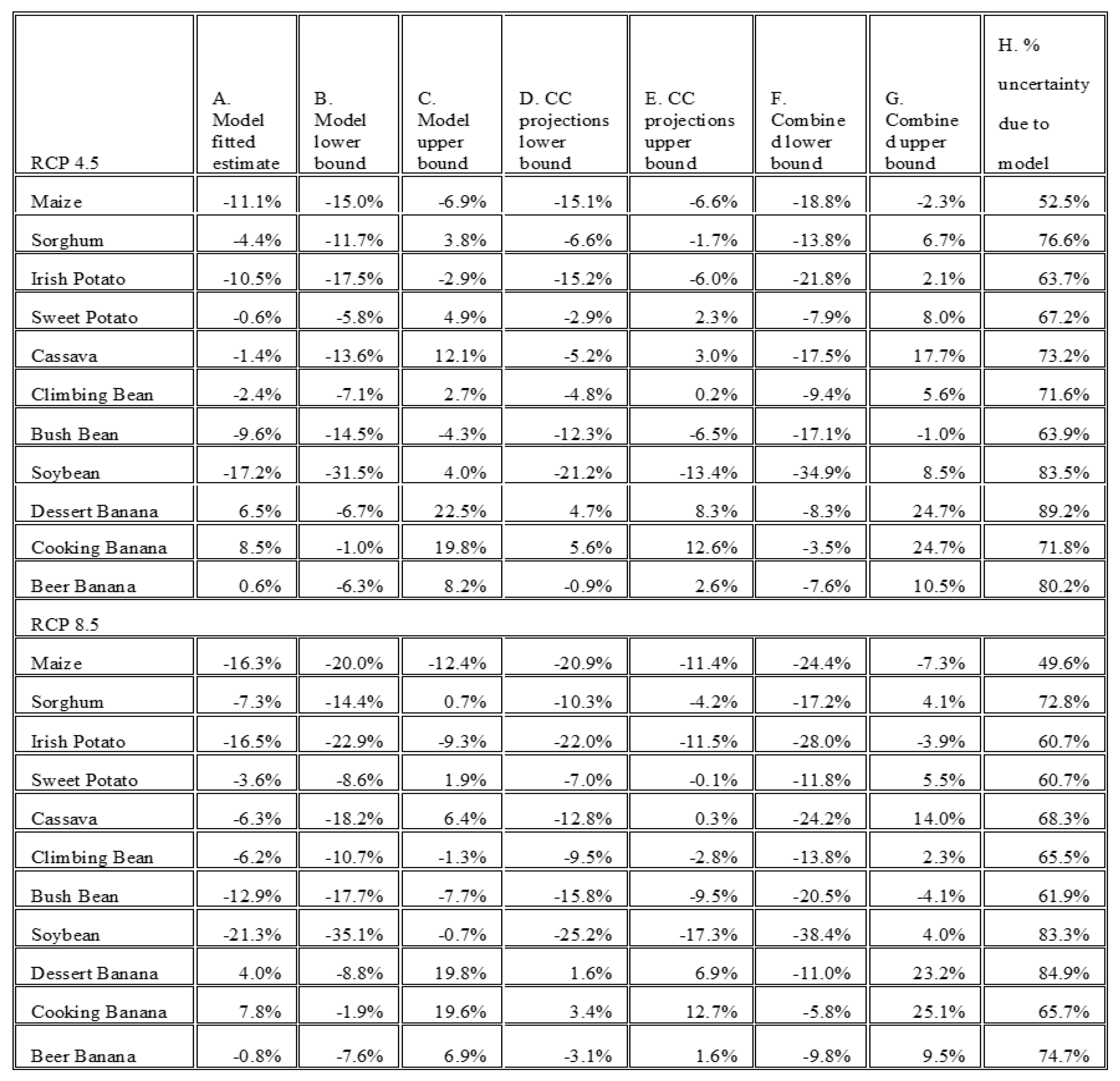
References
- Niang, I.R.; Abdrabo, O.C.; Essel, M.A.; Lennard, A.; Padgham, C.; Urquhart, J.; Africa, P. Climate Change Impacts, Adaptation, and Vulnerability. Part B: Regional Aspects. Contribution of Working Group II to the Fifth Assessment Report of the Intergovernmental Panel on Climate Change; Cambridge University Press: Cambridge, UK; New York, NY, USA, 2014. [Google Scholar]
- Godfray, H.C.J.; Beddington, J.R.; Crute, I.R.; Haddad, L.; Lawrence, D.; Muir, J.F.; Pretty, J.; Robinson, S.; Thomas, S.M.; Toulmin, C. Food Security: The Challenge of Feeding 9 Billion People. Science 2010, 327, 812–818. [Google Scholar] [CrossRef]
- Schmidhuber, J.; Tubiello, F.N. Global food security under climate change. Proc. Natl. Acad. Sci. USA 2007, 104, 19703–19708. [Google Scholar] [CrossRef] [PubMed]
- Thornton, P.K.; Herrero, M. Adapting to climate change in the mixed crop and livestock farming systems in sub-Saharan Africa. Nat. Clim. Chang. 2015, 5, 830–836. [Google Scholar] [CrossRef]
- Thierfelder, C.; Chivenge, P.; Mupangwa, W.; Rosenstock, T.S.; Lamanna, C.; Eyre, J.X. How climate-smart is conservation agriculture (CA)? Its potential to deliver on adaptation, mitigation and productivity on smallholder farms in southern Africa. Food Secur. 2017, 9, 537–560. [Google Scholar] [CrossRef]
- Dube, T.; Moyo, P.; Ncube, M.; Nyathi, D. The Impact of Climate Change on Agro-Ecological Based Livelihoods in Africa: A Review. J. Sustain. Dev. 2016, 9, 256–267. [Google Scholar] [CrossRef]
- Brown, M.E.; Funk, C.C. Food Security Under Climate Change. Science 2008, 319, 580–581. [Google Scholar] [CrossRef] [PubMed]
- Müller, C.; Cramer, W.; Hare, W.L.; Lotze-Campen, H. Climate change risks for African agriculture. Proc. Natl. Acad. Sci. USA 2011, 108, 4313–4315. [Google Scholar] [CrossRef]
- Wheeler, T.; von Braun, J. Climate Change Impacts on Global Food Security. Science 2013, 341, 508–513. [Google Scholar] [CrossRef]
- Müller, C. African Lessons on Climate Change Risks for Agriculture. Annu. Rev. Nutr. 2013, 33, 395–411. [Google Scholar] [CrossRef]
- Knox, J.; Hess, T.; Daccache, A.; Wheeler, T. Climate change impacts on crop productivity in Africa and South Asia. Environ. Res. Lett. 2012, 7, 034032. [Google Scholar] [CrossRef]
- Descheemaeker, K.; Oosting, S.J.; Homann-Kee Tui, S.; Masikati, P.; Falconnier, G.N.; Giller, K.E. Climate change adaptation and mitigation in smallholder crop–livestock systems in sub-Saharan Africa: A call for integrated impact assessments. Reg. Environ. Chang. 2016, 16, 2331–2343. [Google Scholar] [CrossRef]
- Niyitanga, F.; Kabayiza, A.; Niyonzima, J. Assessment of Yield Gaps in Main Staple Crops in Rwanda. IJAIR 2015, 3, 1267–1271. [Google Scholar]
- Rwanda Ministry of Agriculture and Animal Resources. Strategic Plan for Agriculture Transformation 2018-24; Ministry of Agriculture and Animal Resources: Kigali, Rwanda, 2018.
- The World Bank. Rwanda Economic Update: Sustaining Growth by Building on Emerging Export Opportunities; The World Bank: Rwanda Kigali, Rwanda, 2017. [Google Scholar]
- Republic of Rwanda. Green Growth and Climate Resilience: National Strategy for Climate Change and Low Carbon Development; Republic of Rwanda: Kigali, Rwanda, 2011.
- Ndayisaba, F.; Guo, H.; Isabwe, A.; Bao, A.; Nahayo, L.; Khan, G.; Kayiranga, A.; Karamage, F.; Muhire, E.N. Inter-Annual Vegetation Changes in Response to Climate Variability in Rwanda. J. Environ. Prot. 2017, 8, 464–481. [Google Scholar] [CrossRef]
- Bagstad, K.J.; Ingram, J.C.; Lange, G.-M.; Masozera, M.; Ancona, Z.H.; Bana, M.; Kagabo, D.; Musana, B.; Nabahungu, N.L.; Rukundo, E.; et al. Towards ecosystem accounts for Rwanda: Tracking 25 years of change in flows and potential supply of ecosystem services. People Nat. 2020, 2, 163–188. [Google Scholar] [CrossRef]
- National Institute of Statistics of Rwanda. Seasonal Agricultural Survey; National Institute of Statistics of Rwanda: Kigali, Rwanda, 2018.
- Giertz, A.; Mudahar, M.S.; Gray, G.; Rubaiza, R.; Galperin, D.; Suit, K. Rwanda: Agricultural Sector Risk Assessment; World Bank Group: Kigali, Rwanda, 2015. [Google Scholar]
- National Institute of Statistics of Rwanda. EICV3 Thematic Report—Agriculture; Republic of Rwanda: Kigali, Rwanda, 2012.
- Swedesurvey. Report for Production of ortho photo in Rwanda, Rwanda National Land Use and Development Master Plan; Rwanda National Land Centre, Ministry of Natural Resources: Kigali, Rwanda, 2010.
- Meteo Rwanda. Meteo Rwanda Map Room. Available online: http://maproom.meteorwanda.gov.rw/maproom/index.html (accessed on 1 July 2019).
- Verdoodt, A.; Van Ranst, E. Environmental assessment tools for multi-scale land resources information systems: A case study of Rwanda. Agric. Ecosyst. Environ. 2006, 114, 170–184. [Google Scholar] [CrossRef]
- Global Administrative Areas. GADM Database of Global Administrative Areas, Version 2.0. Available online: www.gadm.org (accessed on 1 July 2019).
- Hijmans, R.J. Raster: Geographic Data Analysis and Modelling, R package version 2.6-7; 2016; Available online: https://cran.r-project.org/web/packages/raster/raster.pdf (accessed on 15 May 2020).
- R Core Team. R: A Language and Environment for Statistical Computing; R Foundation for Statistical Computing: Vienna, Austria, 2011. [Google Scholar]
- O’brien, R.M. A Caution Regarding Rules of Thumb for Variance Inflation Factors. Qual. Quant. 2007, 41, 673–690. [Google Scholar] [CrossRef]
- Jeffrey, M.W. Introductory Econometrics; South-Western Cengage Learning: Mason, OH, USA, 2009. [Google Scholar]
- Zeileis, A. Econometric Computing with HC and HAC Covariance Matrix Estimators. J. Stat. Softw. 2004, 11, 1–17. [Google Scholar] [CrossRef]
- Peng, R.D. Simpleboot: Simple Bootstrap Routines, R package version 1.1-7; 2019; Available online: https://cran.r-project.org/web/packages/simpleboot/simpleboot.pdf (accessed on 15 May 2020).
- Ward, P.S.; Florax, R.J.G.M.; Flores-Lagunes, A. Climate change and agricultural productivity in Sub-Saharan Africa: A spatial sample selection model. Eur. Rev. Agric. Econ. 2013, 41, 199–226. [Google Scholar] [CrossRef]
- World Bank Group. Climate Change Knowledge Portal: Rwanda. Available online: https://climateknowledgeportal.worldbank.org/country/rwanda/climate-data-projections (accessed on 12 March 2020).
- Tebaldi, C.; Knutti, R. The use of the multi-model ensemble in probabilistic climate projections. Philos. Trans. R. Soc. A Math. Phys. Eng. Sci. 2007, 365, 2053–2075. [Google Scholar] [CrossRef]
- Hawkins, E.; Sutton, R. The potential to narrow uncertainty in projections of regional precipitation change. Clim. Dynam. 2011, 37, 407–418. [Google Scholar] [CrossRef]
- Kathiresan, A. Strategies for Sustainable Crop Intensification in Rwanda; Ministry of Agriculture and Animal Resources: Kigali, Rwanda, 2011.
- Deutsch, C.A.; Tewksbury, J.J.; Tigchelaar, M.; Battisti, D.S.; Merrill, S.C.; Huey, R.B.; Naylor, R.L. Increase in crop losses to insect pests in a warming climate. Science 2018, 361, 916–919. [Google Scholar] [CrossRef]
- Muhire, I.; Tesfamichael, S.G.; Ahmed, F.; Minani, E. Spatio-Temporal Trend Analysis of Projected Temperature over Rwanda. J. Environ. Sci. Toxicol. Food Technol. 2015, 9, 64–71. [Google Scholar]
- Tenge, N.G.; Alphonse, M.; Thomas, T.S. Chapter 9, Rwanda. In East African Agriculture and Climate Change: A Comprehensive Analysis; International Food Policy Research Institute: Washington, DC, USA, 2013; pp. 247–278. [Google Scholar]
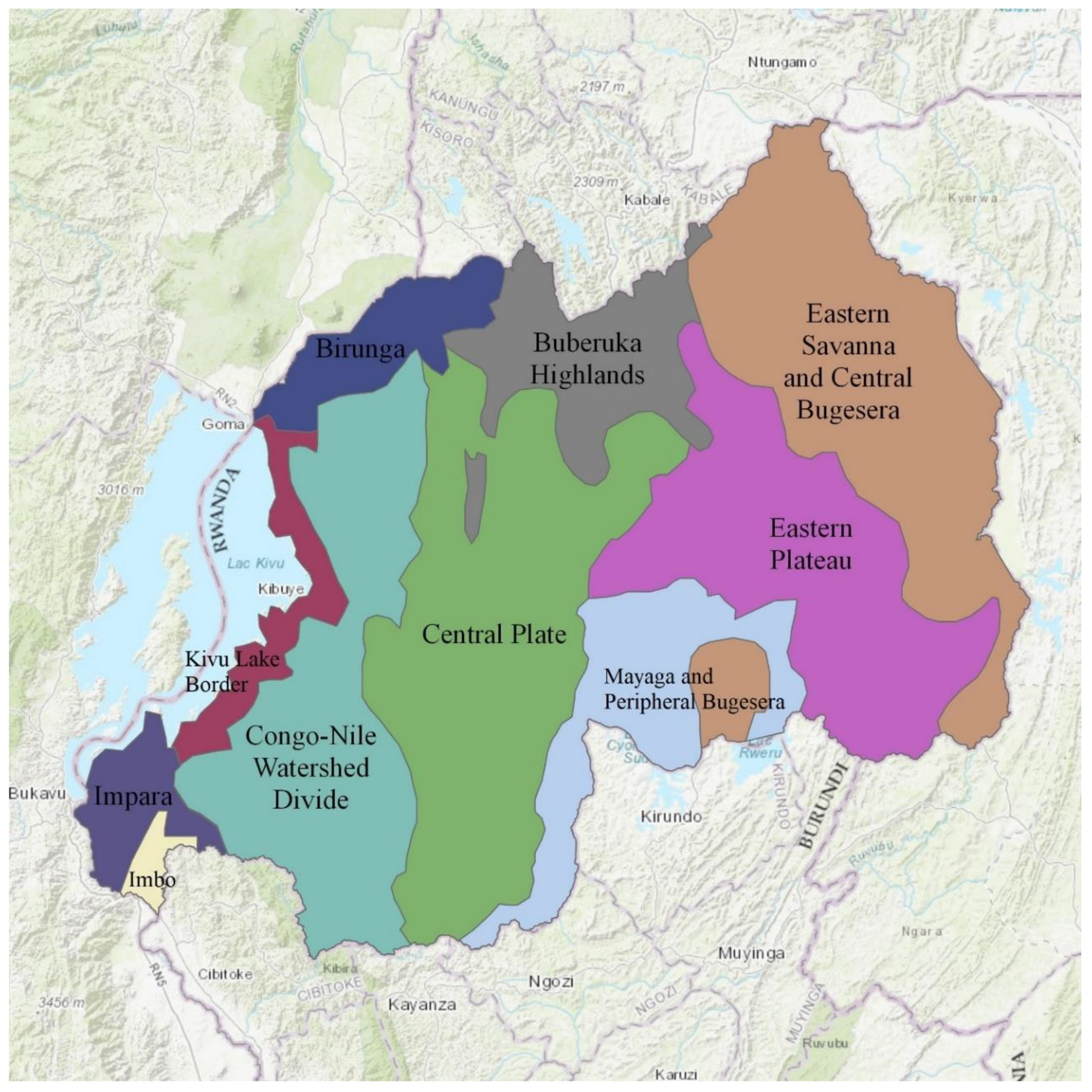
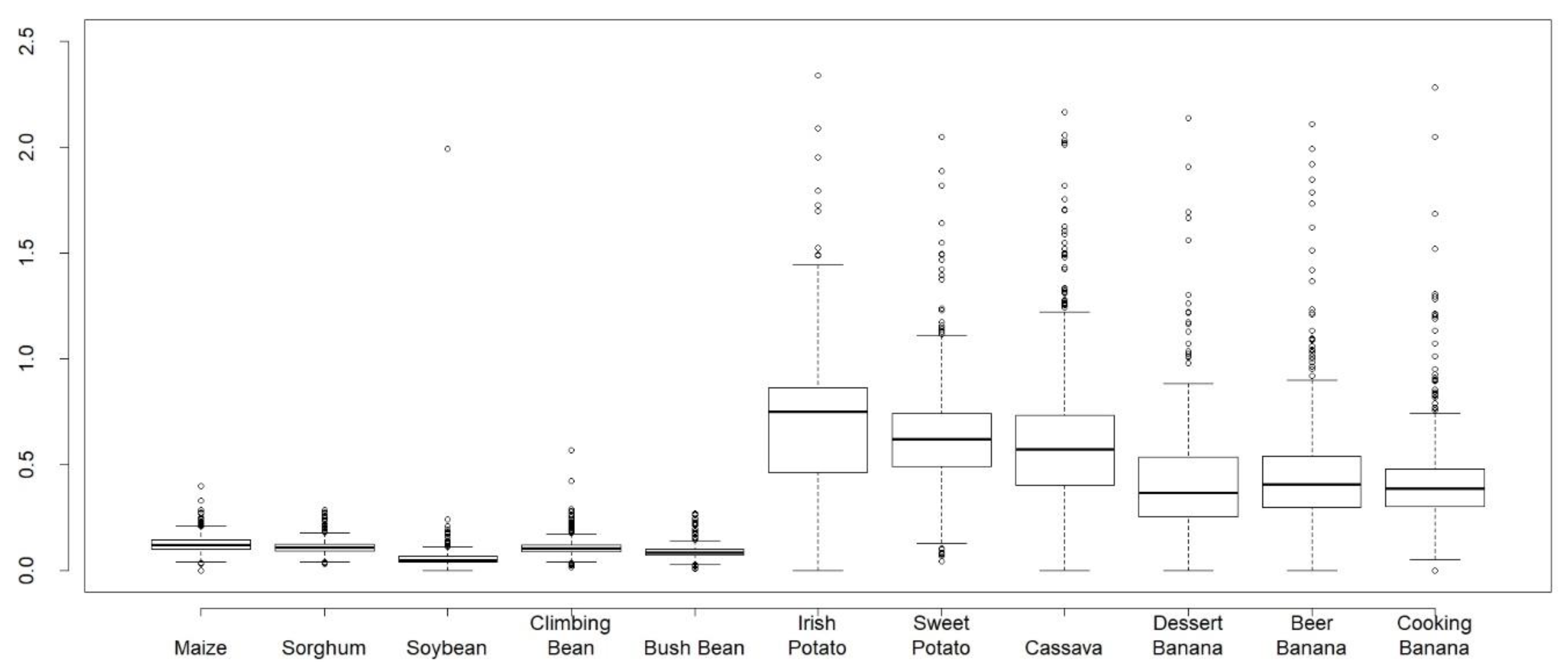
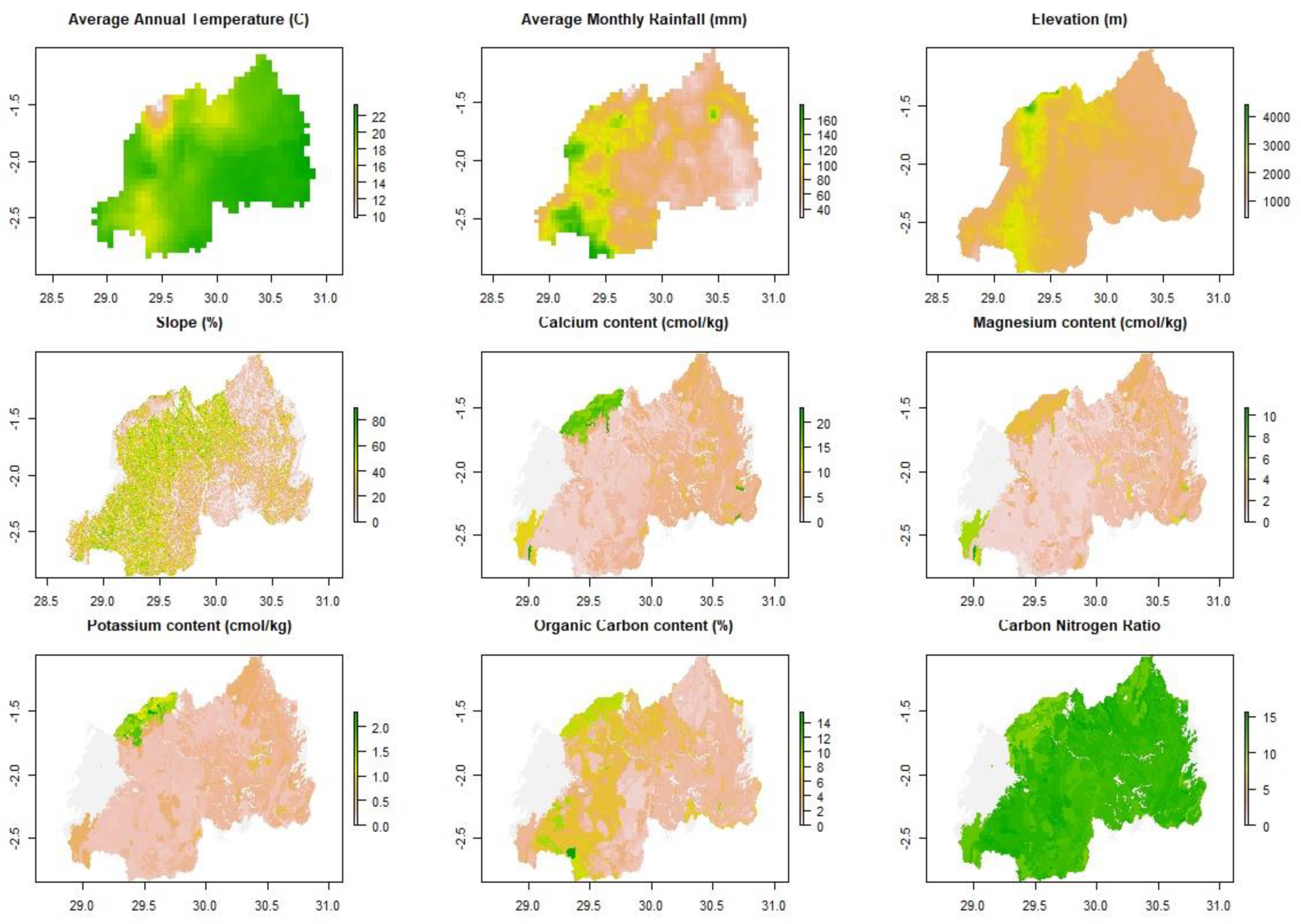

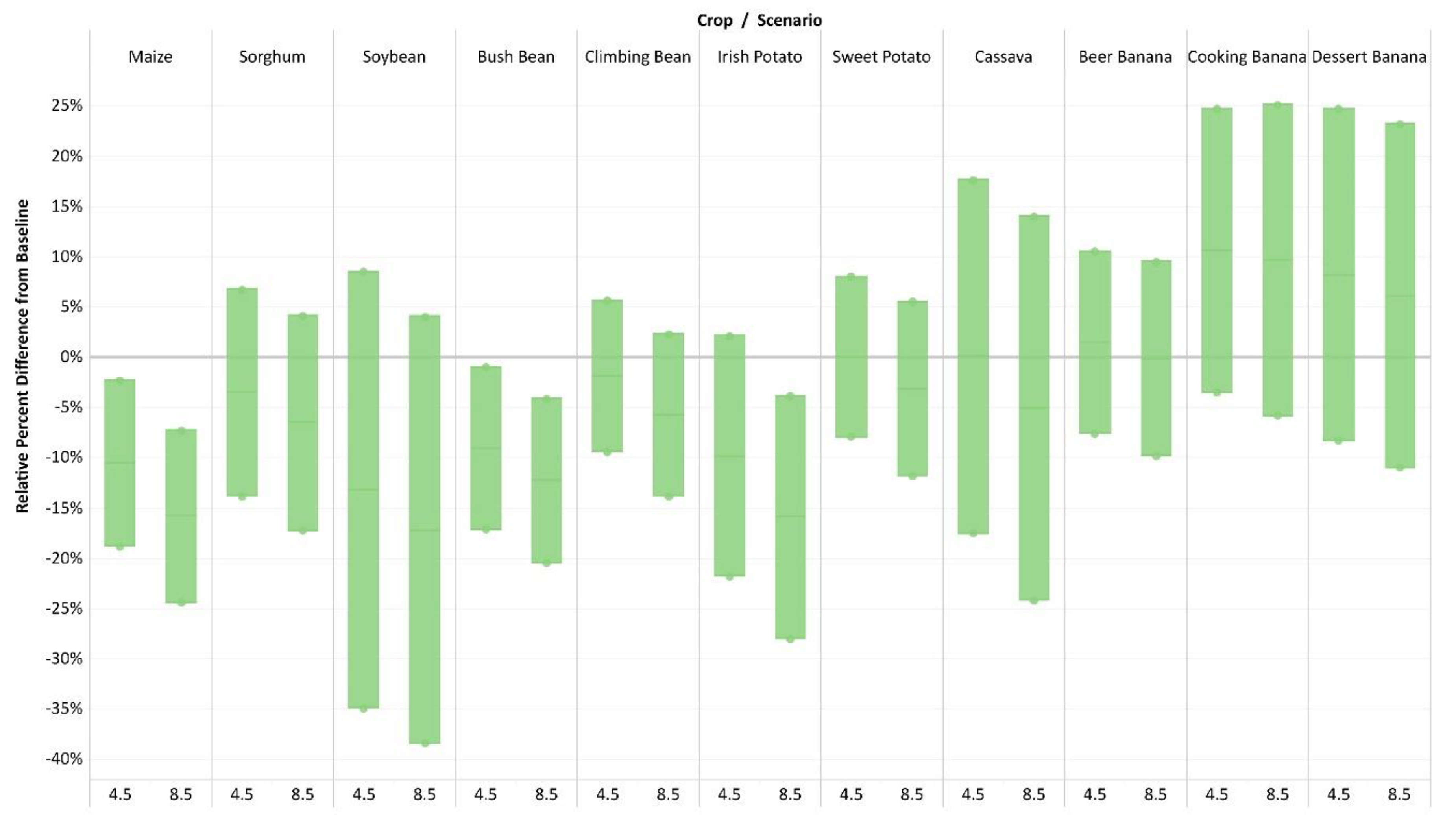
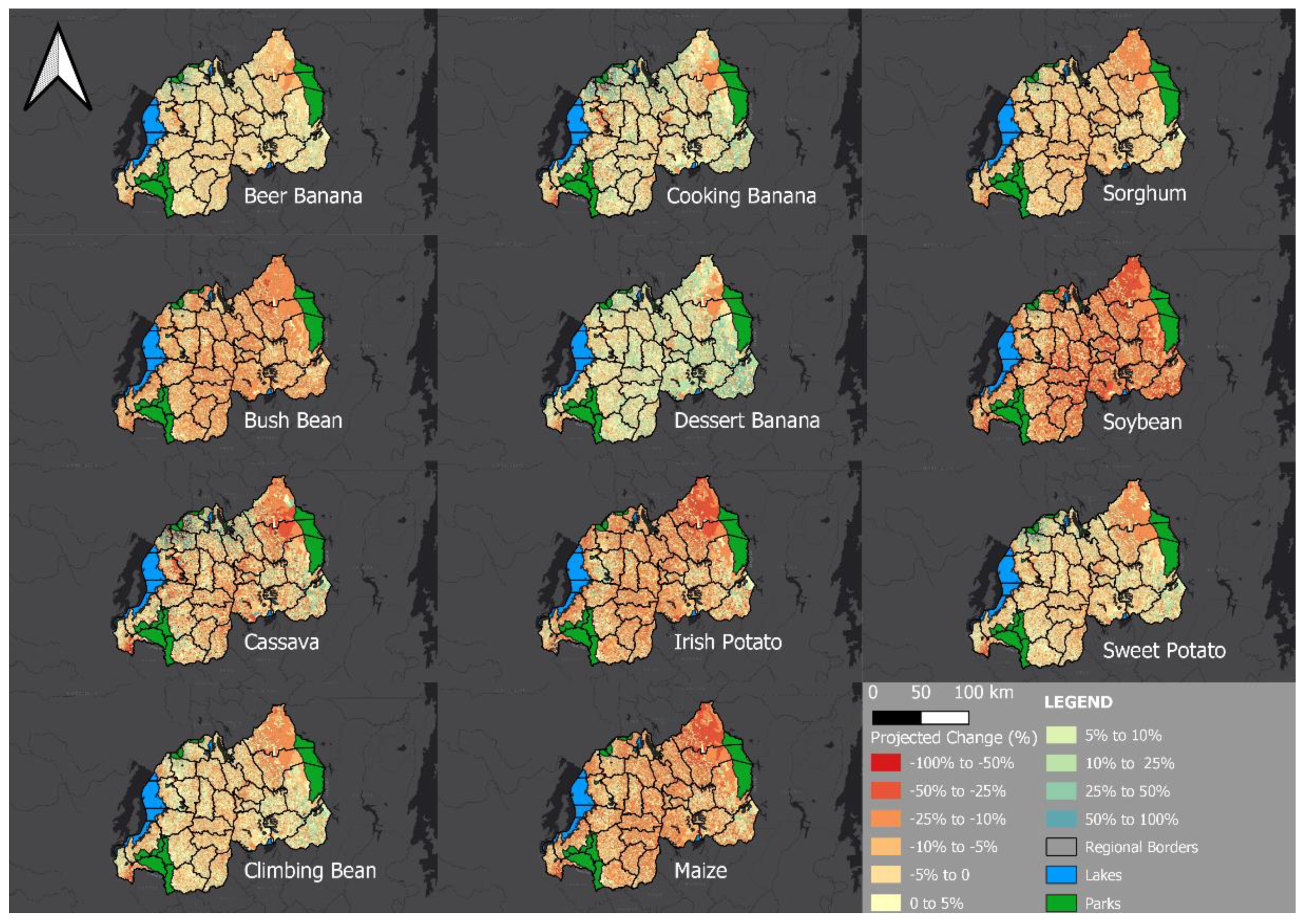
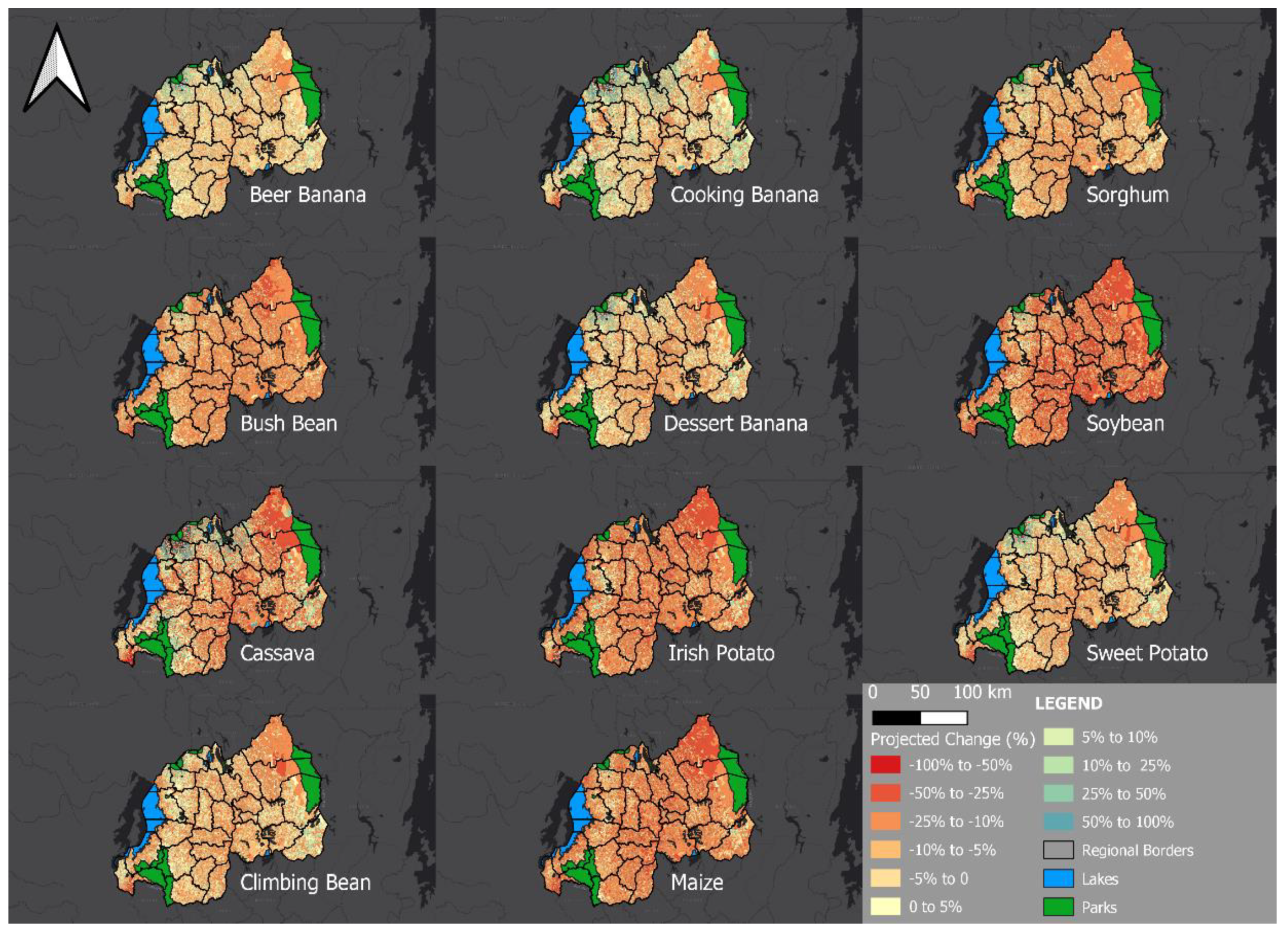
© 2020 by the authors. Licensee MDPI, Basel, Switzerland. This article is an open access article distributed under the terms and conditions of the Creative Commons Attribution (CC BY) license (http://creativecommons.org/licenses/by/4.0/).
Share and Cite
Austin, K.G.; Beach, R.H.; Lapidus, D.; Salem, M.E.; Taylor, N.J.; Knudsen, M.; Ujeneza, N. Impacts of Climate Change on the Potential Productivity of Eleven Staple Crops in Rwanda. Sustainability 2020, 12, 4116. https://doi.org/10.3390/su12104116
Austin KG, Beach RH, Lapidus D, Salem ME, Taylor NJ, Knudsen M, Ujeneza N. Impacts of Climate Change on the Potential Productivity of Eleven Staple Crops in Rwanda. Sustainability. 2020; 12(10):4116. https://doi.org/10.3390/su12104116
Chicago/Turabian StyleAustin, Kemen G., Robert H. Beach, Daniel Lapidus, Marwa E. Salem, Naomi J. Taylor, Mads Knudsen, and Noel Ujeneza. 2020. "Impacts of Climate Change on the Potential Productivity of Eleven Staple Crops in Rwanda" Sustainability 12, no. 10: 4116. https://doi.org/10.3390/su12104116
APA StyleAustin, K. G., Beach, R. H., Lapidus, D., Salem, M. E., Taylor, N. J., Knudsen, M., & Ujeneza, N. (2020). Impacts of Climate Change on the Potential Productivity of Eleven Staple Crops in Rwanda. Sustainability, 12(10), 4116. https://doi.org/10.3390/su12104116





